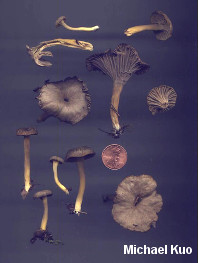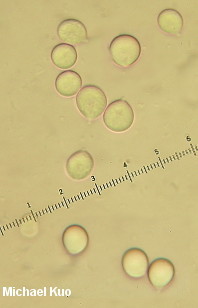| Major Groups > Chanterelles and Trumpets > Cantharellus sphaerosporus |

|
Cantharellus sphaerosporus [ Basidiomycota > Cantharellales > Cantharellaceae > Cantharellus . . . ] by Michael Kuo The basis for separating this species from the virtually identical Craterellus tubaeformis is admittedly pretty thin: Cantharellus sphaerosporus, as its scientific name suggests, has nearly round spores; the spores of Craterellus tubaeformis are generally ellipsoid. Charles Peck named Cantharellus sphaerosporus in 1898, and was able to note the difference in spore shape even with his rudimentary microscope. Macroscopic features, however, parallel those of Craterellus tubaeformis: a brown cap, well-developed false gills that become grayish with age, and a yellow stem with a waxy surface. DNA studies to date have not included Cantharellus sphaerosporus, but given its morphology it will certainly belong in Craterellus as "Craterellus sphaerosporus" if it is actually distinct from Craterellus tubaeformis. A 2010 paper by Buyck and collaborators intended to transfer the species to Craterellus, but did not accomplish the task; although its transfer along with other species is listed in the paper's abstract, sphaerosporus is missing from the taxonomic section of the paper where the transfers are accomplished. Since a "full and direct reference" to Peck's original publication of the species as a Cantharellus (1898) is required by the International Code of Nomenclature (see Article 41.5) for a combination to be effectively published, the Buyck paper's attempted transfer to Craterellus is unfortunately not valid. Description: Ecology: Mycorrhizal with conifers, including eastern hemlock; growing gregariously or in loose clusters in moss or on well-decayed, moss-covered logs in conifer bogs; northern North America; summer and fall. The illustrated and described collection is from Michigan. Cap: 2-5 cm wide; convex at first, soon becoming vase-shaped and eventually becoming perforated on the center; with a wavy and irregular margin when mature; bald; somewhat wrinkled; sticky or waxy when fresh; dark brown, fading to grayish brown. Undersurface: With well developed, distant false gills that fork near the margin and have very few cross-veins; whitish to yellowish, becoming grayish to yellowish or brownish. Stem: 3-5 cm long; 3-8 mm thick; more or less equal; becoming hollow; bald; brownish above and dark brownish yellow below; basal mycelium white. Flesh: Insubstantial; whitish to yellowish or brownish. Odor and Taste: Not distinctive. Spore Print: White to yellowish. Microscopic Features: Spores 7-10 x 6-9 µ; subglobose to very broadly ellipsoid; smooth; hyaline in KOH; contents minutely granular. Basidia 4-sterigmate; 75-80 µ long. Elements of upper surface cylindric; 2.5-7.5 µ wide; septate; clamped; smooth; brownish to brown in KOH. REFERENCES: Peck, 1898. (Saccardo, 1902; Smith, 1968; Petersen, 1976; Bigelow, 1978.) Herb. Kuo 09040204. This site contains no information about the edibility or toxicity of mushrooms. |
© MushroomExpert.Com |
|
Cite this page as: Kuo, M. (2015, February). Cantharellus sphaerosporus. Retrieved from the MushroomExpert.Com Web site: http://www.mushroomexpert.com/cantharellus_sphaerosporus.html |

